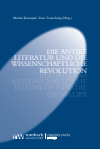Zusammenfassung
In der frühen Neuzeit griffen Autoren in großem Umfang auf antike Formen und Vorbilder zurück, um ihrer Leserschaft neue Erkenntnisse über die Natur nahezubringen. Die zwölf Beiträge des Sammelbandes thematisieren erstmals diesen aus heutiger Sicht überraschenden Befund. Sie nehmen eine breite Palette von Autoren und Textgattungen – von Hippokrates bis Leibniz und vom Aphorismus bis zum Lehrgedicht – in den Blick und fragen zugleich nach Konstanten in der Vielfalt der Formen und Inhalte. Der Band richtet sich an alle, die an der klassischen Antike, ihrer Rezeption, der Geschichte der Naturwissenschaften und der Geistesgeschichte der frühen Neuzeit interessiert sind. Mit Beiträgen von Dr. William Barton; Dr. Dominik Berrens; Prof. Dr. Reinhold Glei; Dr. Johanna Luggin; Prof. Ian Maclean; Dr. Philipp Roelli; Prof. Dr. Bernd Roling; Eva Sahr, M.A.; Dr. Petra Schierl; Prof. Dr. Claudia Schindler; Dr. Grigory Vorobyev und Prof. Dr. Otta Wenskus.
Abstract
In the early modern period, authors drew extensively on ancient forms and models to introduce their readership to new insights into nature. The twelve contributions in this anthology are the first to address this finding, which is surprising from today’s perspective. They examine a wide range of authors and text genres—from Hippocrates to Leibniz and from aphorisms to didactic poems—and at the same time ask for constants in the diversity of forms and content. The volume is aimed at anyone interested in classical antiquity, its reception, the history of the natural sciences and the intellectual history of the early modern period. With contributions by Dr. William Barton; Dr. Dominik Berrens; Prof. Dr. Reinhold Glei; Dr. Johanna Luggin; Prof. Ian Maclean; Dr. Philipp Roelli; Prof. Dr. Bernd Roling; Eva Sahr, M.A.; Dr. Petra Schierl; Prof. Dr. Claudia Schindler; Dr. Grigory Vorobyev and Prof. Dr. Otta Wenskus.

